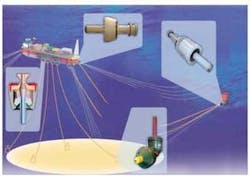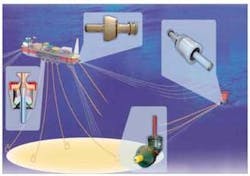Hutchinson reorganization combines flex-joint/deck mating expertise
Two French specialists in elastomeric/rubber components for offshore use are now working together as part of the Hutchinson engineering group. Techlam, acquired last July from jet engine manufacturer Snecma Moteurs, has since been assimilated with existing subsidiary Paulstra into Hutchinson’s Aerospace-Industry division.
Despite that title, both companies are being encouraged to develop new devices for offshore use around and below the water line. Paris-based Paulstra’s offshore specialties are fender systems for protecting jacket legs, and shock absorbers for ultra-heavy deck/jacket mating operations.
Techlam, based in Cernay, eastern France, was created in 1988, with the aim of devising products for the latest generation of submarines and nuclear missiles. But this was the period when the Cold War was petering out, forcing the company to pursue openings in other sectors. One of these was offshore oil and gas - following advice from BP and other operators, Techlam began engineering flexible joints in the mid-1990s for use with deepwater risers and floating production export lines.
To this end, the company developed a rubber compound called HNBR (hydrogenated acronytrile butadiene rubber). This was first applied in a major offshore context in single and double flexible joints on two 16-in. rigid oil export lines between the Girassol FPSO and associated loading buoy. That contract was awarded by Elf in 1999, with the field coming onstream in 2001.
These flexible connections between two rigid assemblies were designed to withstand the impact of export line tension loads, high temperatures and oil, with a rotation angle of up to 21° in a single arrangement, and 36° in a dual configuration.
Once the technology was proven - no damage was reported even when three mooring lines on the Girassol buoy came loose - further commissions followed from other operators for deepwater floaters off West Africa. ExxonMobil opted for 20-in. single flexible joints for the Kizomba A and B and Erha export lines, rated for 6.6 kN axial loads in the case of the Kizombas. More recently, Techlam has been contracted for the design and supply of single joints for Greater Plutonio (BP), Agbami (Chevron) and Akpo (Total).
According to Techlam’s Offshore Sales Manager Jean-Piere Chaumieau, the flexible joints are installed relatively easily, by pulling the offloading line through receptacles welded to porches both on the FPSO and the buoy. “They can withstand heavy tension loads and large movements of the FPSO and/or buoy, over a 25-year design fatigue life, with a safety factor of 10.”
The company’s next development was much larger diameter flexible elements for riser tower base connections, also applicable to TLP tendon seabed connectors. Applications to date include 63-in. receptacle latching systems for installing the base joints of riser towers on Rosa and Greater Plutonio, and 10 connectors for water and gas injection single hybrid risers on Kizomba A and B.
Now Techlam is focusing on steel catenary production riser flexible joints, a market currently dominated by Oil States. Under a second-phase joint industry project involving support from BP and Statoil, and R&D assistance from Hutchinson in particular, Techlam has been working on a new system suited to deepwater developments with severe operating conditions, i.e. high pressure, high temperature, and sour production fluids, such as H2S and CO2. Full-scale prototype trials will be performed this year to qualify the concept, including fatigue and explosive decompression tests.
The HTHP-FSDB (fail-safe double barrier) joint is designed currently to withstand temperatures up to 120°C, pressures of 75 MPa, and tension loads of up to 7,000 kN. The device is insulated throughout with new rubber formulations -- with Hutchinson R&D support -- providing strong resistance to explosive decompression. If this year’s tests prove successful, Techlam expects the joint to be qualified for 100% of production SCRs.
Platform connections
Paulstra’s main current offshore project involves two giant platforms under construction in the Far East. Here it is providing a total of eight leg mating units (LMUs), designed to facilitate smooth contact between the platform substructures and decks during this summer’s offshore installation program.
These are the biggest shock absorbers the company has ever produced and will be installed in each of the platforms’ four legs. Each LMU comprises four rings, 2.6 m in diameter and 1.4 m high in total, operating with a stroke of 0.7 m, and capable of withstanding a maximum load in each case of 6,500 ton, and a lateral force of 2,000 tons.
The central guiding pipe within the leg mating units is 1.2 m in diameter. All elastomer parts were manufactured at the company’s factory in northern France, where fatigue tests were conducted on 1:10 scale models. Industeel in central France subcontracted full-scale tests (with all four rings in operation) using its in-house 10,000 ton press.

